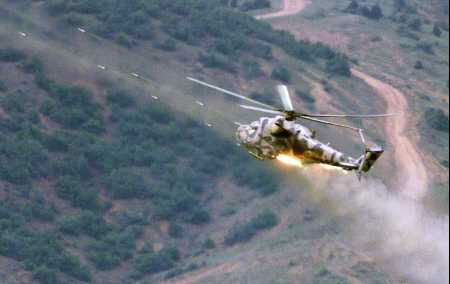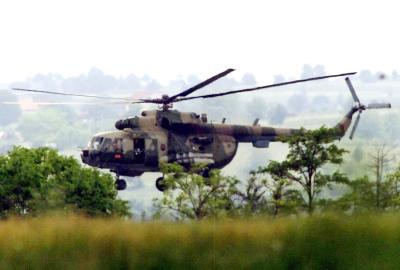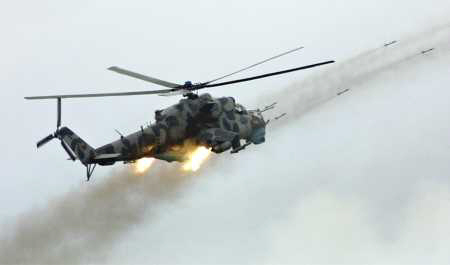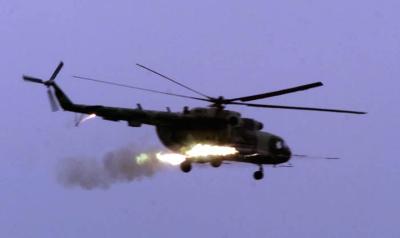|
Enter content here
Macedonia's Powerful Helicopter Fleet.
Reality Macedonia - Dnevnik
 Macedonian Mi-24V
On a regional level, in the fighter helicopter department, Macedonia comes second only to Greece. Too bad it had to accept no-fly zones over its own occupied territory during the Albanian aggression, when NATO-imposed ceasefire constrained only the victim, and not the NLA.
By Igor Bozhinovski
Translation by Zlatko Arsenievski
On several occasions during the past week, the media questioned the condition of the aircrafts in the Macedonian Air Force. This was a direct consequence of lack of knowledge of the fact that, there is no 100% fault-free aircraft fleet in the world. The world experiences say that level of fault-free readiness for even the most powerful armies is between 80% and 90%. Dropping of readiness to bellow 70% is considered a reason for alarm, but the aircrafts in the Macedonian Air Force are far above that. In one of my past reviews, I've exposed my personal perspective about the military condition of the Macedonian Air Force, which by my opinion, after Greece, has the most powerful helicopter fleet in the near region. In addition, I would like to explain this perspective, which is based on the readiness, number and types of aircrafts owned by Macedonia's neighboring countries.
 Macedonian Air Force's Mi-8MT
In the beginning, I would like to point out, that because of many objective and subjective facts, the comparison between the armed forces of the Greek Republic and the Macedonian Army, or any other country in the region might not be considered suitable. Greece, the only Balkan member of the NATO and EU, today has 180 helicopters aimed at various purposes, from which only 20 are AH-64A Apache. Macedonia, on the other hand, has 12 Mi-24 fighter helicopters, all in excellent shape.
 Macedonian Mi-24V in action
Krumovo air-base, near Plovdiv, is the site of the complete helicopter fleet of the Bulgarian Air Force. Bulgaria uses fighter helicopter Mi-24 as basic air support for the ground forces. The reform of the Bulgarian armed forces, envisages retaining 24 helicopters of this type, which are currently in rather desperate condition. Already catastrophic condition of Bulgarian helicopters Mi-24D/V worsened even more after a storm hit the helicopter base Stara Zagora in the summer of 1999. The strong hail destroyed the main rotor blades of all helicopters parked there. So far, the Bulgarians managed to repair only four helicopters of the Mi-24 type. 25 Mi-17 helicopters reside in Krumovo, also. In the transport/fighter configuration are 19 of them, while four of them are in ECM - electronic counter messure configuration (Mi-17PP). Level of technical readiness of all of these helicopters is catastrophically low. In the 1999 the helicopter base of Krumovo was reinforced with 6 new helicopters of the type Bell 206B-3, and in the 2000 with the luxury helicopter Bell 430 used for transport of high state officials. With the exception of the helicopters "Bell", the greater part of the Bulgarian Air Force is grounded due to lack of resources or reserve parts.
The condition of Yugoslav Air Force is not much better either. Readiness level of approximately 120 various helicopters is critically low, due to the many years of international embargo for import of weapons and military equipment, and the cut-backs in the military budget. Yugoslav Air Force uses about 40 helicopters of the type Mi-8 for transport and transport/fighter tasks. They also have about 40 anti-tank helicopters of the type SA.342L Gazele-GAMA. Additional 40 aircrafts of the type SA.341H Gazele-HERA are used as light multi-purpose helicopters. Yugoslav police also has two Mi-24V fighter helicopters.
 Mi-8MT
Albania is a country which definitely has the weakest and most obsolete Air Force in Europe, and is at the low end of World scale, also. Most of Albanian aircraft have been grounded or put out of service during the late 1990s, due to severe lack of fuel and reserve parts. The only refreshment of the Albanian Air Force was the several light multi-purpose helicopters donated by USA and Switzerland. Currently, Republic of Albania is the only country in the region without fighter helicopters.
Further equipping of the Macedonian Air Force with light multi-purpose and transport helicopters in combination with already established norms for adequate service of the aircrafts, would establish it as the second-most powerful helicopter fleet in the region, after Greece.
NUCLEAR PLANT - REPAIRS.
BTA
Vratsa, April 20 (BTA) - The 440 MW Unit 2 of the Kozlodoui Nuclear Power Plant was brought off stream for scheduled annual repairs at 2.25am Saturday, the plant's PR office said.
The reactor was closed in accordance with the plant's repair schedule, following a decision by the Central Operation Control Department (COCD) and a check by the Committee on the Use of Atomic Energy for Peaceful Purposes.
During the period of the repair, the reactor will be refuelled and its operational safety will be upgraded, the plant said.
Unit 2 is entering its 24th refuelling cycle. The reactor went into operation in 1975 and its design life is equivalent to 30 refuelling cycles. The facility has been repeatedly upgraded under programmes for Units 1 through 4.
The 440 MW Units 1 and 3 are also undergoing scheduled repairs. Unit 1 was brought off stream on March 9 and is currently being refuelled. An upgrade of the emergency protection system of Unit 3 was launched on February 17; the procedure involves installation of a jet vortex condenser.
Unit 4 (440 MW) is operating at 52 per cent of its design output, and the 1,000 MW Units 5 and 6 at 78 per cent and 85 per cent, respectively.
The current output level is set in accordance with the COCD operational programme.
|



